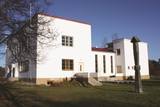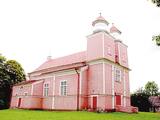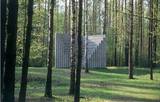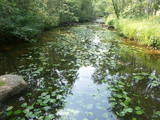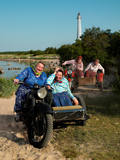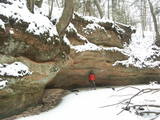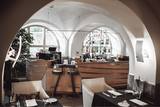| Нo | Название | Описание |
|---|---|---|
|
This is an easy 3-day route, suitable for any traveller ready to take some steps outside the capital and get into the woods. You will start the tour by taking a train from Rīga to Ķemeri. The walk will start in the Ķemeri resort park leading to the legendary sulphur spring and continue to the “Forest House” – the visitor’s centre of the Ķemeri National Park. The park is established for the protection of mainly wetlands – the shallow coast of the Gulf of Riga, the overgrown seaside lakes, the vast marshlands, mires (forests) and flood plans. Besides, there is the wooden plank Melnalkšņu swamp forest trail. Next, the Forest Trail takes one to the Lake Sloka, a shallow coastal lake with rich aquatic plants, sulphur springs and important migratory bird rest areas. On the banks of it, there is a 7 m high floating bird-watching tower. Further, the Forest Trail runs to the Gulf of Riga in the small fishermen village of Bigauņciems, where it joins with the Baltic Coastal Hiking Route (E9 European long distance path). From there on, the trail runs along the coast direction Jūrmala – the most popular resort town in Latvia with the widest sandy beaches. The tour ends in Ragakāpa Nature Park, which is established to preserve the dunes covered in old pine forests and natural diversity of the seaside. The Jūrmala Open-Air Museum is a place to get to know a traditional local fishermen’s farmstead. |
||
|
Построен в 1939 году «при содействии своего отечества Латвии и с помощью родственных народов - финнов, эстонцев и венгров». В первое воскресенье августа здесь отмечают праздник Ливов. |
||
|
This is a route for hikers and bicyclists, starting at the village of Vaidava and then moving along the eastern shore of the narrow Lake Vaidava, which has steep cliffs around it. The trip covers the Veļķi baronial estate, the “Swedish pine”, the famous Vaidava (Metimne) hillfort, a series of streams, the great Rubene rock, the Vaidava baronial estate on the western shore of the lake. After that, the trail leads the visitor back to the starting point.
|
||
|
Стоит в городище Бейдас – на самом верху крутого склона долины Тебры (запружена Мельничным прудом). Церковь построена в городище куршей, где стояла укрепленная деревянная крепость Бейда древней земли куршей Бандавы. Первые сведения о храме относятся ко второй половине XIII века. Церковь неоднократно восстанавливалась и перестраивалась. Теперешний облик (готика) церковь приобрела во время перестройки в 1860 году и после того, как в 1730 году возвели башню. Это одна из старших церквей Курземе. До XVI века она была католическая, позже перешла в собственность лютеранского прихода. В церкви находится орган (1904 г.) фирмы «Зауэр», алтарь (вторая половина XIX века), надгробнаяплитаепископа Курляндского Х. Базедова (XVI в.), колокол (1589 г.) и др. |
||
|
Находится в южной части поселка Феймани. Церковь построена в период времени с 1756-го по 1760-й год. Фреймани были собственностью рода баронов фон Корфов. Церковь принадлежала разным конфессиям в соответствии с изменением вероисповедания Корфов, перейдя из лютеранства в католичество. Стоит упомянуть, что Фейманская католическая церковь выделяется среди церквей Резекненского края наибольшим количеством памятников искусства государственного значения. Среди них стоит отметить исповедальную скамью, скамьи богомольцев, органный проспект, серебряные ковши и пятнадцать, в том числе 18-го века, резных декоров из дерева. Возле входных ворот церкви высится колокольня с четырьмя колоколами. На Страстной неделе вместо колоколов в церкви используют т.н. «колотушки», представляющие собой предметы 2 м длиной и 1 м высотой, напоминающие старинные бельевые катки. В Феймани находится одна из трех мастерских в Латвии по изготовлению знамен, в которой установлено современнейшее оборудование в Балтии. В этом месте как идейно, так и физически «родилось» знамя Латгалии. |
||
|
~6,000, including nearly 300 types of dahlias, 120 types of azaleas, and 100 types of outdoor rhododendrons.
The conservatories of the botanic gardens contain various exotic and tropical plants and fruit trees, including lemon, banana, pineapple, fig, olive, avocado and coffee bean plants. There is a broad collection of cacti, as well as the largest collection of palm trees in Latvia. Outdoors, there are lots of winter-resistant plants, medicinal plants, and poisonous plants. The plants are arranged in systematic groups – something which is typical only of the botanic gardens of universities. This is the only place in Latvia where you can see so many flowering magnolias in a single place in the spring.
Outdoors you will find the Sweet Chestnut (Castanea sativa), the Gingko (Ginkgo biloba), the Dawn Redwood (Metasequoia glyptostroboides), the White Mulberry (Morus alba), and the Common Walnut (Juglans regia). The conservatories include several types of the highland tamarin (Araucaria bidwillii and A. heterophylla), the Wollemia Pine (Wollemia nobilis), the Moreton Bay Fig (Ficus macrophlla), the Water Lily (Victoria regia), etc.
|
||
|
The trail climbs up and down along the bluffs of lower River Pilsupe and reveals a fascinating sight of three white dune exposures (the largest is called the White Dune). The dune range has formed in the period of the Littorina Sea several thousands of years ago. The time required to walk the trail is ~0.3 h. Evidence of Stone Age settlements have been found in the vicinity. |
||
|
Das Museum vom Zentrum Europas. Gegründet vom litauischen Bildhauer Gintaras Karosas. Mehr als 100 von Künstlern aus den 33 Ländern errichtete Installationen sind unter freiem Himmel ausgestellt. |
||
|
The tower is on the western shore of the lake, next to the dam and the Zvidze canal. From here you will see the overgrowth north-western part of the lake, Akmeņsala Island, and a wide area of open water. The third is on the southern shore of the lake, by the dam and the Īdeņa canal. Here you will find typical views of wetlands – areas of reeds, shrubbery, wet meadows and the overgrown lake. |
||
|
Суйты - одна из самых ярких, разнообразными культурными традициями богатых общин в Курземе и в Латвии. Доказательством этому служит факт, что 1 октября 2009 года Культурное пространство Суйтов было включено в Список всемирного нематериального наследия ЮНЕСКО, которое требует срочного спасения. Культурное пространство Суйтов включено также в список народных традиций Латвийских канонов культуры. Проявления, характеризующие нематериальное Культурное наследие Суйтов - традиционные праздники, народные обычаи, устная традиция, традиционное пение и музыкальные навыки, традиционные народные костюмы и кулинарные традиции. С 2009 года община Суйтов переживает ренессанс, а это означает, что часть общины проводит активные действия по сохранению традиций, обеспечению жизнеспособности и их подвижению на местном, национальном и на международном уровне. Жизнеспособность Культурного пространства Суйтов находится в руках представителей общины, так как основывается на практическом применении и креативности представителей общины. Суйты считают развитие туризма в своем культурном пространстве одной из важных областей развития самого культурного пространства. В частности, подчеркивая нишу культурного туризма, основанную на продвижении уникального Культурного наследия Суйтов в более широком масштабе. |
||
|
This territory protects a lime outcrop found on the shores of the lower reaches of the Zaņa River. There is a path for active hikers which begins at the Zaņa mill (1864, rebuilt 1890, shut down 1960). The path weaves its way along the steep shores of the little river, heading toward its mouth.
|
||
|
Занесенное в список всемирного наследия ЮНЕСКО культурное пространство Кихну (www.kultuuriruum.ee) представляет собой своеобразный сплав настоящего и прошлого. В музее Кихну есть все, что касается повседневной жизни- орудия труда, одежда, рукоделие, мебель. |
||
|
Ainavisks, ap 340 m garš un līdz 15 m augsts atsegums, kas atrodas nepilnu kilometru lejpus Raunas ietekas Gaujā, kreisajā pamatkrastā. To veido sarkandzeltenīgi Gaujas svītas smilšakmeņi. Gar Kazu ieža austrumu daļas pakāji izkaisīiti vairāki lieli laukakmeņi, kas ērti iekārtojušies uz smilšakmeņos izskalotas pamatnes. |
||
|
Atrodas Daugavas prospektā 10, starp Rīgas – Daugavpils šoseju (A 6) un Kalēju ielu. Dievnams celts laikā no 1931. - 1933. g. (arhitekts: Pēteris Kundziņš). Padomju gados tajā bija izvietota Latvijas Valsts bibliotēkas grāmatu glabātava. Pateicoties draudzes aktivitātēm 1989. g., ēku atjaunoja. Tagad tā kalpo savam pamatmērķim. |
||
|
The Kaļķupe River valley was established as the Pilsupe River (formed by Kaļķupe River and Mazupe River) crossed the Blue hills of Šlītere to the South of Vīdale and Kaļķi. The distinct river valley has a branched network of gullies in which Devonian sandstone has been uncovered and can be seen in some locations. Puiškalns Hill (located at confluence of Kaļķupe River and Mazupe River), which was used as a castle hill and as a sacred location long in the past, is one of the most distinctive parts of the area. It is a popular tourist destination in the Talsi District. Hillside forests, various kinds of meadows and a wide range of plants are also of value in the local environment. |
||
|
Сааремаа может гордиться старинными, пережившими века и сохранившимися до сих пор традициями пивоварения. В Курессааре ‒ в здании с элементами арт-деко, где когда-то вырабатывали электричество, а сейчас открыта пивоварня Pöide ‒рождается искусство пивоварения. Здесь Вы узнаете множество секретов изготовления пива, а в отдельном помещении сможете продегустировать готовую продукцию. |
||
|
Небольшая речушка, отличающаяся глубокой, но широкой долиной, которую пересекает дорога Вецумниеки – Илуксте. Название Вилкупе связано с амбициозным планом Курземского герцога Екаба о соединении бассейна рек Даугавы и Лиелупе. Работы, связанные с соединительным каналом, начались, но проект так и не был полностью воплощен в жизнь. В этом плане Вилкупе отводилась роль одной из составных частей канала. В этой связи стоит подумать о масштабе идей и творческих инновациях человека средневековья. Фрагмент канала отмечен и подлежит осмотру на расстоянии неполных 4 км от населенного пункта под названием Вилкупе. |
||
|
Pасположен в здании с богатой историей. Когда-то здесь находился рыбный рынок, и это оказало свое влияние на направление ресторана. Ресторан предлагает широкий выбор рыбных блюд и морских деликатесов, а также изысканные блюда из мяса. В наличии также вегетарианские блюда и детское меню. |
||
|
This tour offers visiting UNESCO World Heritage sites – Helsinki, Stockholm, Riga, Tallinn, travelling by ferries and cruise ships and adding value to the trip by exploring the Baltic countries beyond the capitals. The sites outside cities present traditional folk cultures of Finland, Sweden, Estonia and Latvia and a variety of farms showing today’s life in the countryside. The roundtrip includes two overnights on cruise ships. |
||
|
Tītuvēnu reģionālais parks (Tytuvėnų regioninis parkas) dibināts 1992. gadā. Parkam raksturīga ainavu daudzveidība – te ir sastopami lieli mežu masīvi, purvi, ezeri, upītes. Šejienes reljefa veidotājs tāpat kā citur Baltijas valstīs ir bijis ledājs, kas atnesis un atstājis aiz sevis garas laukakmeņu grēdas. Kopumā parkā ir konstatētas 603 augu un 787 dzīvnieku sugas. Parkā aug veci un dabiski boreālie (ziemeļu) meži, veci un jaukti platlapju meži ar ozoliem, liepām, kļavām, ošiem un gobām, sugām bagāti egļu meži, staignāju meži, nogāžu un gravu meži, purvaini meži un aluviālie (pārplūstošie) meži. Parkā esošās pļavas un tīrumi ir nozīmīga dzērvju atpūtas vieta migrāciju laikā, kad te pulcējās tūkstošiem putnu. Šiluvas baznīca un Tītuvēnu klosteris ir svētceļnieku galamērķis vairāk nekā 500 gadu garumā. |
||


